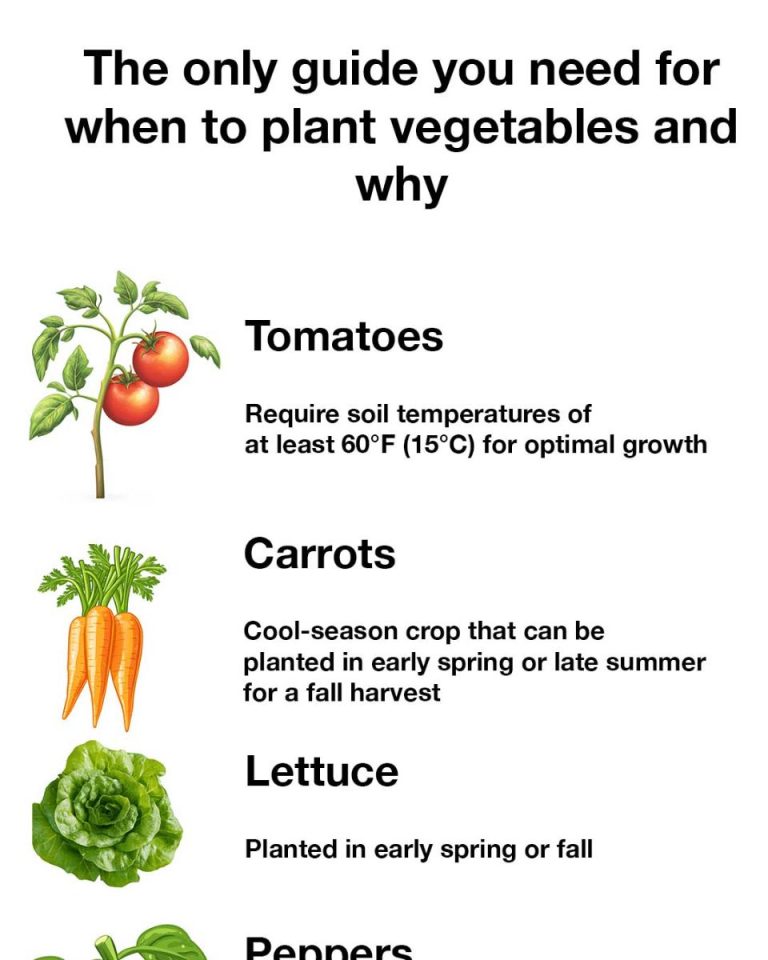The only guide you need for when to plant vegetables and why

The Science Behind Planting Seasons
Planting seasons are determined by the climate and weather patterns of a region. The primary seasons for planting are spring and fall, each offering different advantages. Spring planting takes advantage of warming temperatures and longer daylight hours, while fall planting benefits from cooler temperatures and reduced pest pressure. Understanding the science behind these seasons, including soil temperature and moisture levels, helps gardeners choose the optimal time to plant each type of vegetable.
When and Why to Plant Tomatoes
Tomatoes thrive in warm weather and should be planted after the last frost date in your area. They require soil temperatures of at least 60°F (15°C) for optimal growth. Planting tomatoes too early can result in stunted growth or frost damage. By waiting until the soil and air temperatures are consistently warm, you ensure that your tomato plants will grow vigorously and produce abundant fruit.
Optimal Planting Time for Carrots and Their Benefits
Carrots are a cool-season crop that can be planted in early spring or late summer for a fall harvest. They prefer loose, well-drained soil and require consistent moisture for proper root development. Planting carrots at the right time ensures that they mature before the heat of summer or the cold of winter, resulting in sweeter, more tender roots.
Growing Lettuce: Timing and Advantages
Lettuce is a fast-growing, cool-season vegetable that can be planted in early spring or fall. It thrives in temperatures between 60°F and 70°F (15°C to 21°C). Planting lettuce during these cooler periods prevents bolting, which occurs when the plant goes to seed prematurely, resulting in bitter leaves. By timing your lettuce planting correctly, you can enjoy fresh, crisp greens throughout the growing season.
The Best Season for Planting Peppers and Why It Matters
Peppers are warm-season vegetables that require a long growing season and should be planted after the last frost. They need soil temperatures of at least 70°F (21°C) to germinate and grow effectively. Planting peppers at the right time ensures that they have enough time to mature and produce fruit before the first fall frost, maximizing yield and flavor.
Cucumbers: When to Plant for Maximum Yield
Cucumbers are another warm-season crop that should be planted after the danger of frost has passed. They prefer soil temperatures of 70°F to 95°F (21°C to 35°C) and require plenty of sunlight and water. By planting cucumbers at the right time, you can ensure a continuous harvest throughout the summer, as they grow quickly and produce abundantly.
Planting Spinach: Timing and Nutritional Benefits
Spinach is a nutrient-rich, cool-season vegetable that can be planted in early spring or fall. It thrives in temperatures between 50°F and 60°F (10°C to 15°C). Planting spinach during these cooler periods prevents bolting and ensures tender, flavorful leaves. Spinach is packed with vitamins and minerals, making it a valuable addition to any garden.
The Right Time to Plant Broccoli and Its Impact
Broccoli is a cool-season crop that can be planted in early spring or late summer for a fall harvest. It requires temperatures between 65°F and 75°F (18°C to 24°C) for optimal growth. Planting broccoli at the right time ensures that it matures before the heat of summer or the cold of winter, resulting in firm, flavorful heads.
Growing Onions: Seasonal Tips and Health Benefits
Onions can be planted in early spring or fall, depending on the variety. They require well-drained soil and consistent moisture. Planting onions at the right time ensures that they have enough time to develop large, flavorful bulbs. Onions are rich in antioxidants and have numerous health benefits, making them a valuable addition to any diet.
When to Plant Beans for Best Results
Beans are warm-season vegetables that should be planted after the last frost. They prefer soil temperatures of 70°F to 85°F (21°C to 29°C) and require full sun. Planting beans at the right time ensures that they have enough time to mature and produce a bountiful harvest before the first fall frost.
The Ideal Time to Plant Zucchini and Why
Zucchini is a warm-season crop that should be planted after the danger of frost has passed. It requires soil temperatures of at least 70°F (21°C) and plenty of sunlight. Planting zucchini at the right time ensures a continuous harvest throughout the summer, as it grows quickly and produces abundantly.
Planting Corn: Timing and Its Significance
Corn is a warm-season crop that should be planted after the last frost when soil temperatures reach at least 60°F (15°C). It requires full sun and well-drained soil. Planting corn at the right time ensures that it has enough time to mature and produce sweet, tender ears before the first fall frost.
The Best Season for Planting Peas and Their Benefits
Peas are a cool-season crop that can be planted in early spring or late summer for a fall harvest. They prefer temperatures between 55°F and 70°F (13°C to 21°C). Planting peas at the right time ensures that they mature before the heat of summer or the cold of winter, resulting in sweet, tender pods.
When to Plant Potatoes for Optimal Growth
Potatoes are a cool-season crop that can be planted in early spring or late summer for a fall harvest. They require well-drained soil and consistent moisture. Planting potatoes at the right time ensures that they have enough time to develop large, flavorful tubers before the first fall frost.